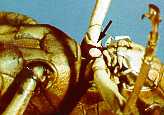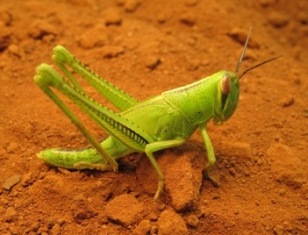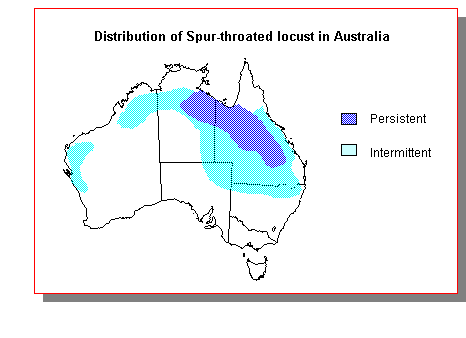The spur-throated locust, Austracris guttulosa, is mainly a tropical species and swarms of immature adults form in savannah areas of the Central Highlands and northwest Queensland, in the Northern Territory and northern Western Australia in late autumn and winter. Spur-throated locusts also breed in southern Queensland and the northwest plains and central west of NSW. The species has a single generation each year. Breeding commences at the start of the northern wet season and adults often migrate prior to egg laying. Nymphs are present from December to March.
Spur-throated locusts are an infrequent but important pest of agriculture in parts of New South Wales, Queensland and Western Australia. They feed on all types of crops and summer crops, such as sorghum, sunflowers and soybeans, are particularly susceptible as they are present when the locusts are most active. Damage to winter crops tends to occur in the autumn just after sowing when the locusts are fledging and at the late ripening stage in spring when the locusts are beginning to mature. However, extensive damage to wheat during the winter has been known to occur in crops adjacent to roosting sites.
The Department of Industry & Investment NSW has produced a Fact sheet for this species, which provides further information on the lifecycle and management of this species.
[expand all]
Description
The spur-throated locust, Austracris guttulosa, is readily distinguished from other pest species of locusts and grasshoppers by its large size and the presence of a spur, or throat-peg, between the front legs.
The adults are pale brown in colour with white stripes and dark markings on the thorax. The hindwings are colourless or have a bluish tinge. The shanks of the hind legs are straw or mauve coloured and bear two rows of dark-tipped white spines. Adult males measure 55-65 mm long and females are 70-80 mm long.
Young nymphs are bright green. Older nymphs have a distinct pale or dark stripe down the middle of their back and often change in colour from green to straw coloured.

Adult spur-throated locust

Spur on the underside of an adult locust

Fifth instar nymph
More images of this species can be found in the APLC Locust and grasshopper identification guide
Biology and behaviour
Number of generations
The spur-throated locust has one generation per year. Adult locusts live 10-12 months, from autumn of one year until the following summer.
Oviposition and egg development
Spur-throated locusts spend the autumn and winter as immature adults in diapause. Egg maturation begins with the first rains in the wet season, usually during October-November, and lasts 2-3 months. During dry years, they in may not lay eggs until February or even March.
As with all locusts, eggs of this species are laid in the soil. The female drills a hole into the ground using her ovipositor and lays the eggs in a group called a pod. Egg pods contain an average of 130 eggs and females have the potential to lay several pods within their life-span. Unlike the Australian plague locust, however, female spur-throated locusts do not congregate to form dense egg beds when laying. Egg laying occurs over a wider area, although females tend to lay near areas of short grass, on headlands between crops or on banks of irrigation channels.
Eggs laid in moist soil take 20-30 days to develop depending on temperature. Eggs laid in dry soil enter a quiescent state and do not resume development until further rain falls. Spur-throated locust eggs are not able to stay in quiescence for prolonged periods and many die if dry soil conditions continue for more than a month.
Nymphs
Nymphs of spur-throated locusts do not aggregate into bands, although they can be found in high densities near favoured grasses. Young nymphs are most common in short grasses and ephemerals while older nymphs are found in taller vegetation.
Nymphs take about 10 weeks to reach the adult stage and have six to eight instar stages. Nymphs are more susceptible to dry conditions that those of the Australian plague locust and the long period of nymphal development means they are vulnerable to mortality if regular rainfall does not occur. Nymphs are usually present from December-March, but if the wet season is delayed and hatching is late, nymphs can be present well into autumn.
Adults
Fledging usually occurs during March-April but can occur as early as January if egg laying occurred in November. At the end of the wet season the newly fledged, pre-reproductive adults enter an overwintering diapause state and move to their winter habitat, often forming dense swarms. During winter these adults roost in trees, particularly in tree-lines along water systems or woodland adjacent to grassland, although they may move down to feed on the vegetation below the trees during the warmer part of the day. When numbers are high they can defoliate trees and even cause branches to break under the weight of many thousands of individuals. The overwintering diapause state is maintained until increasing photoperiod and temperatures during late spring trigger the resumption of reproductive development and accelerated fat accumulation. It takes at least 15 days for male and 20 days for female adults to reach sexual maturity after diapause is broken and egg laying can then commence from late October (typically 7 – 9 months after fledging) if there are heavy rains in northern NSW or early rains in tropical Queensland.
Migration
Spur-throated locusts undertake nocturnal, wind-assisted long distance migrations from the beginning of the wet season. Between October and January numerous large adult population movements may occur, often associated with the passage of tropical depressions. Migrations totalling 700-1000 km have been reported. These migrations can result in redistribution of populations in the tropics and an increase in locust densities in southern Queensland, northern NSW and northern South Australia early in the breeding season. Young adults of the following generation may also migrate after fledging during autumn.
Distribution
The major breeding areas of the spur-throated locust are in the Gulf region of northern Australia in monsoonal tropical grasslands, extending south into the Central Highlands of Queensland. The climate of the northern region is characterised by a distinct summer wet season and a winter dry season. This species also breeds in southern Queensland, northern Western Australia and the northwest plains of New South Wales.

Swarming populations regularly develop in the Central Highlands of Queensland and in northwest Queensland and the Northern Territory around the Gulf of Carpentaria, shown as the area of persistent distribution on the map above. In the early summer the locusts disperse from the winter habitats to areas of dense, tall grass which provide food and shelter for the nymphs and fledglings. Migrations at that time redistribute locusts more widely and in favourable seasons breeding occurs in the intermittent parts of the species range. Young adults also migrate in the autumn and low numbers of locusts are often found in southern New South Wales, northern South Australia and as far south as Victoria.
